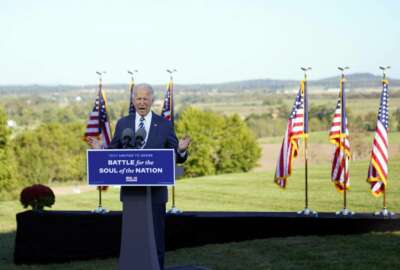
Don’t expect same defense spending priorities under a Biden administration
With some details, Todd Harrison, senior fellow and director of defense budget analysis at the Center for Strategic and International Studies, joined Federal Drive...
Best listening experience is on Chrome, Firefox or Safari. Subscribe to Federal Drive’s daily audio interviews on Apple Podcasts or PodcastOne.
There is no end to the important priorities for the Defense Department and the armed services it operates, but there is a limit to the dollars they can expect. And they can expect shifts in priorities as a new administration comes into authority. With some details on that sketch, we turn to Todd Harrison. He’s a senior fellow and director of defense budget analysis at the Center for Strategic and International Studies, and he joined Federal Drive with Tom Temin.
Interview transcript:
Tom Temin: I want to ask you a specific question first. And that concerns the nuclear enterprise, which involves the Navy and the Air Force and several different platforms. And there has been a long debate about how to modernize, how much to modernize, whether or not we replace warheads – all of these questions. And the submarines are under construction, and maybe a new bomber, and on and on it goes. So that seems like a good way to maybe gauge what we might see in terms of priorities. What do you see ahead there?
Todd Harrison: Yeah, well, I would say overall, we should expect more continuity than change, believe it or not. If you start at the top level strategy for national security and our national defense strategy, the focus is likely to remain on ways that we can counter Russia and China and maintain deterrence against them. And when you take it down to the nuclear enterprise in particular, and you look at the different programs underway, we are in the process, and this actually started under the Obama administration, of recapitalizing all three legs of the nuclear triad simultaneously. It’s a big bill, it’s a big budget bill that’s coming due. But we’re buying the new Columbia-class subs, that’ll be our sea-based leg of the triad. The B-21 bomber is in development, and is supposed to go into production in the next few years. So in the next term of office, we’re going to see B-21s rolling off the assembly line, that’ll be our new bomber that will also be nuclear-capable. And then we’ve got what they call the ground-based strategic deterrent. That is a new ICBM to replace the Minuteman III ICBM that dates back to the 1970s. So all three of those are in progress at once. I don’t actually envision any major changes in those programs. If there was one to change, it might be the ICBM replacement. But if you dig into the details on that, there’s actually not a lot of wiggle room in the schedule of that program, because the current ICBMs are aging out, and they’re not going to be safe, you know, in a few years, and so you’ve got to have something to replace it. And absent a new treaty with Russia, we’re not going to be able to make significant reductions, or it’s not likely we’re going to do it unilaterally.
Tom Temin: And then well, you surprise me a little bit, I guess, continuity would be a good thing for the military over, you know, a period of time. And what about –
Todd Harrison: There are a few areas though, in the nuclear enterprise, where we will see changes. It’s changes that Trump made that are likely to get rolled back. So, you know, two in particular – one is the fielding of low-yield warheads. That’s something the Trump administration did quickly. They rolled it out quickly. I think that’s something that we’ll see a Biden administration possibly roll back and just take those low-yield warheads out of the inventory. The other thing is the Trump administration had talked about a new sea-based nuclear armed cruise missile. They had not actually started a program to develop that yet. But if they were planning on one, I think that that’s something that will be scrapped by the Biden administration.
Tom Temin: That low yield sounds sort of like grandson of the neutron bomb, if you’re old enough to remember that one.
Todd Harrison: Yes.
Tom Temin: And what about the Navy? Because there’s been a sudden shift in recent weeks, almost, from the 355 whatever, to the 500 with more Corvettes and lower price platforms, but more of them – a swarming, maybe almost, if you will. Do you think that will survive? And will that strategy finally take root so that there can be some cogent program backup to it?
Todd Harrison: Yeah, so the Navy’s future force plans have never been rationalized in terms of realistic budget constraints. And so the Navy has been kind of coming up with these budget unconstrained plans. But yeah, it’s been, you know, 355 or more crewed ships. And then if you include the uncrewed ships, then you’re talking well over 500 ships. It’s not going to happen. It’s not realistic from a budget perspective. And I think that we will see the Biden administration start to add some more realistic constraints on Navy planning.
Tom Temin: Because you did have Mark Milley, an Army man, saying he’d even give up Army budget to help the Navy expand. That just came out a couple days ago, but you don’t see it happening.
Todd Harrison: The amount of funding it would take is just not realistic to expect. And you know what, in the next four years or eight years, you’re not going to make that much progress towards those enormous ship counts anyway. You know shipbuilding, these are long-lead items. They take a long time to develop it, so you’re not going to get there quickly anyway.
Tom Temin: We’re speaking with Todd Harrison, senior fellow and director of Defense Budget Analysis at the Center for Strategic and International Studies. And what about the Army, because the army has another, different type of dilemma: How to maintain the ability to do the suppression kinds of things it’s been doing for so long, and also become more strategic with the China/Russia question. And there’s not enough money to go around and cover that whole bed either.
Todd Harrison: Yeah, well, I think this is an area where we’re going to see change, but there’ll be more continuity in the change. So the Army has already been, over the last four years on the losing end of a lot of budget battles. We’ve seen the Army’s share of the budget slipping over time. And we see more questions about some of the Army’s modernization priorities and how do they fit into the priorities of the national defense strategy? There are a lot of open questions there. And so I think what we’ll start to see over the next few years in the Biden administration, is they’re going to have to start making some of those tough calls and say, Well, you know, what, if we’re going to fund the priorities for nuclear modernization, priorities in the Navy, and in the Air Force for countering Russia and China, then some of these programs in the Army, especially the ground vehicle programs, and some of the helicopter programs as well, they’re not going to rise to the same level of priority. And so I think we could see some reductions. And the other thing that’s been a long time coming is serious reductions in the size of the Army, overall army and strength. I think, if push comes to shove with the budget that the Army is going to lose for structure, it’s going to lose personnel in that fight.
Tom Temin: Because they’re touching roughly the 500,000-man regular army, a little bit less. How far down do you think it could go?
Todd Harrison: I think it could go as low as 400,000. I wouldn’t be surprised if it went below 400,000 in the active duty Army, but I think we’re looking at a, you know, potentially significant reduction, because honestly, if you want to save money in the Army, the Army’s all about people cost. And if you need to cut back, and you need to take risk somewhere and you look at the national defense strategy, the army, you know, Army force structure, army end strength is a likely target.
Tom Temin: So the strategy then really then implies that nobody sees a army-to-army ground war type of scenario, no matter how we might have to take on Russia or China?
Todd Harrison: Right, it’s not going to be a symmetrical force-on-force fight on the ground. If anything, the Army is going to have to start to refocus more on long-range fires, on how it can operate over longer distances outside the range, or at least on the edge of, Russian and Chinese anti-access area denial systems, because they’re not going to be able to get close with the enemy. We’re not looking at tank-on-tank, infantry-on-infantry-type battles. It’s going to be asymmetric battles.
Tom Temin: And then there’s the Air Force, which has lots of aging platforms, and they can’t quite seem to get that F-35 over the line in a meaningful way. And then I imagine people would wonder, well, will this B-21 ever actually get over the line, because the F-35 is now – what a 20-some-year-old-program – still not really finished?
Todd Harrison: Yeah, we don’t have a good track record when it comes to fielding stealthy aircraft and the quantities that are initially projected. You look back, you know, at the F-117, the F-22, the B-2 programs have been cut short. And you know, we could be heading to a similar scenario for the F-35. Right now, support in Congress for the F-35 is off the charts. They keep forcing the Air Force to buy more planes than they request each year. But that’s something if push comes to shove in the budget debate, we could see the support for the F-35 start to soften a bit. We’re not going to see the program canceled by any means. But we could see quantities cut back. The B-21. I think actually, at least at this point, has you know, more firm Support. Program’s going to have to deliver, we’re going to have to start to see, real tangible results, aircraft being fielded over the next few years. But right now, I think that program is probably in better shape.
Tom Temin: And that’s a program that wouldn’t have the thousands that were envisioned for the F-35 but maybe 25 or 30 or something?
Todd Harrison: Well, right now the baseline plan has 100 bombers, but if you look at the Air Force’s projected inventory for bombers, we’re still going to be flying B-52s, out until probably the year 2040. What is eventually going to replace those? We only have one bomber in production, there’s only one option: The B-21. So there’s the possibility if this production line keeps going into the 2030s that we may end up buying well over 100.
Tom Temin: Or they could dig out the blueprints for the B-52 and just put some more of those together. That’s never really happened, that type of thing. And finally, what about the rest of the military establishment, the fourth estate? Do you see much change coming there? I know it’s expensive and every administration tries to pare back the cost there, including the health costs.
Todd Harrison: Yeah, so that is a perennial target. And you know, it’s true that there are a lot of opportunities to gain efficiencies and do things more effectively in this fourth estate. But you know, I wouldn’t bank on that being the magical silver bullet that fixes everything. I think that this administration, like previous administrations, will come in and will, you know, have some sort of an efficiency initiative, will target the Fourth Estate, they’ll make a little bit of progress. But the truth is, and this actually came out on a panel discussion that I moderated earlier this week with Peter Levine and Bob Hale and Elaine McCusker – all veterans of DoD. The truth is that you can make some progress, but a lot of the efficiency savings you can get out of the Fourth Estate, they actually require an upfront investment, and they require time to start to pay off. And so it’s just a matter of do we have the political will to inflict the pain that efficiencies cause, and the patience to see it through?
Jared Serbu: Todd Harrison is senior fellow and director of Defense Budget Analysis at the Center for Strategic and International Studies. We’ll post this interview at www.FederalNewsNetwork.com/FederalDrive.
Copyright © 2025 Federal News Network. All rights reserved. This website is not intended for users located within the European Economic Area.
Tom Temin is host of the Federal Drive and has been providing insight on federal technology and management issues for more than 30 years.
Follow @tteminWFED
Related Stories






